| |
The
Making of a Flame Job - Part 2
by Frank Colgoni |
| |
|
|
|
If day one was labour intensive because of the effort to perfect
the layout from scratch, day 2 was about transferring that layout
to the prepared body and readying it for paint.
At
the end of day 1, Ron had taken the artwork with him and had “pounced”
it using a pounce wheel. Pouncing is a process of creating a continuous
series of small holes in the pattern using the pounce wheel tool.
The wheel resembles a mini pizza cutter except instead of a blade,
there are a series of points that create perforations. When the
tool is run around the perimeter of the flames, tiny holes are
created. In order to get the give in the paper pattern to permit
the perforation, a self-healing mat is used underneath the paper
when pouncing. These mats are available in various sizes and are
commonly used when cutting paper and fabric (like quilting fabric
using a rotary cutter).
Ron
begins the day by placing the perforated artwork back on the car
using the registration marks as positioning guides. Once in place,
Ron uses a chalk bag and dabs the pattern over the entire layout
so that the perforations are treated to the chalk. The flame layout
is taking shape underneath the paper.
Once
the original side of the car is treated, the pattern is removed,
flipped and taped to the opposite side using the centre line as
a guide. By doing this, a perfect symetrical layout is possible.
Magic! The flip side is then chalked and the pattern is removed.
I’m going to take it with me for posterity.
|
| |
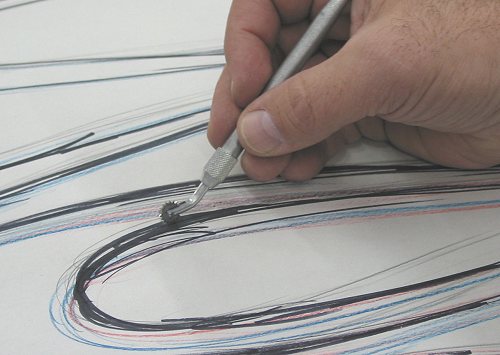
The pounce wheel |
| |
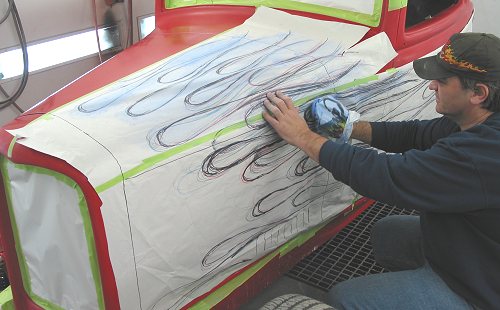 Ron
chalks over the perforations in the banner paper.
Ron
chalks over the perforations in the banner paper. |
| |
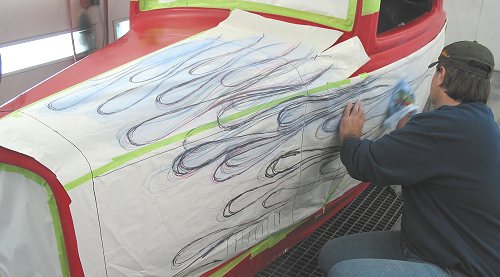 This
continues until this side then the opposite are completed.
This
continues until this side then the opposite are completed. |
| |
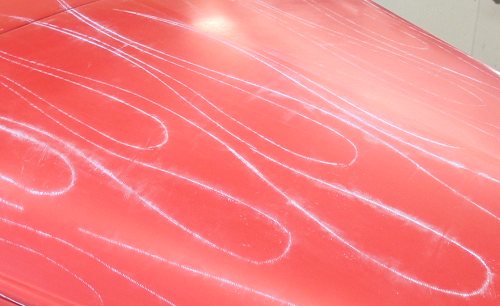 When
the paper is removed, the layout is visible in chalk.
When
the paper is removed, the layout is visible in chalk. |
| |
 A
perfect mirror image of the driver's side.
A
perfect mirror image of the driver's side. |
| |
Before
the layout is transferred to tape, back taping is completed on any
seams where paint will blow by, such as in between the hood and
sides and doorjambs. You want the paint to go into those areas so
that you don't see any cutoff points where the flames make a transition
from panel to panel. Obviously, everything under the hood is masked
off as well as paint will find it's way in there through the tiniest
of openings.
Now the taping of the layout can begin. As with the original sketch,
Ron begins on the hood at the centre line and works across, then
down and back. This is accomplished using 1/8 “ green, 3M,
masking tape. Ron explains that the narrow width is necessary to
keep the tape flat and accommodate the curves.
It
absolutely incredible to watch this process as Ron moves fast
and is accurate. Only a few corrections are needed over the entire
layout. Don’t get me wrong though, this is still a lot of
work.
Once
the entire layout is outlined using the 1/8” tape, Ron tapes
into the doorjambs around the hood and in between the rad shell
and the hood sides. After this detail the areas between the flames
(the “negative” areas that won’t receive paint)
are completely masked off using wider ¾” tape.
|
| |
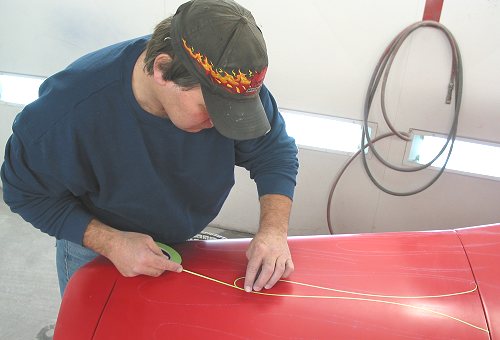
Ron begins the taping of the layout using the 1/8"
tape. |
| |
 Ron
is able to move quickly. You'd almost think he'd done this before..
Ron
is able to move quickly. You'd almost think he'd done this before... |
| |
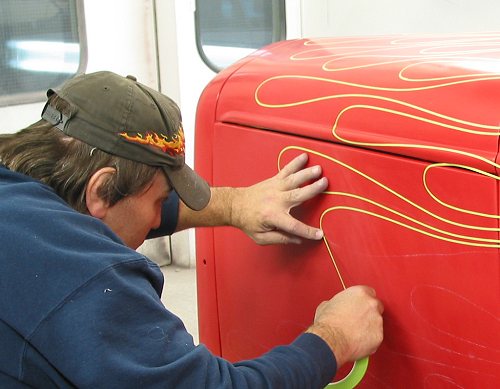 There's
an art to taping a curve.
There's
an art to taping a curve. |
| |
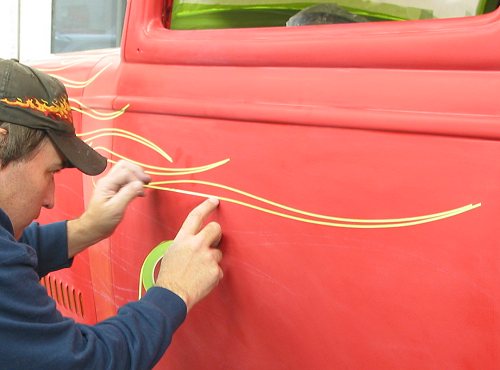 And,
a long flowing lick.
And,
a long flowing lick. |
| |
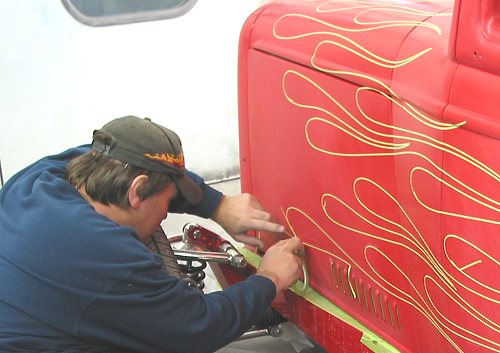 Ron
had to drape himself over the tire to get at the bottom-most part
of the hood side.
Ron
had to drape himself over the tire to get at the bottom-most part
of the hood side. |
| |
 Side
one is complete. Looks very good.
Side
one is complete. Looks very good. |
| |
 Ron
completes the hood. The whole design is really coming alive.
Ron
completes the hood. The whole design is really coming alive. |
| |
 At
this point the negative areas get filled in. Ron moves quickly through
this.
At
this point the negative areas get filled in. Ron moves quickly through
this. |
| |
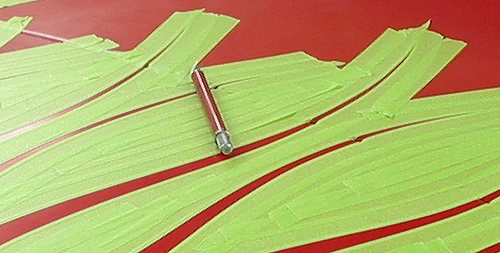 You
can see in thie photo that the seams are still covered over.
You
can see in thie photo that the seams are still covered over.
Ron has his knife ready to remedy this. |
| |
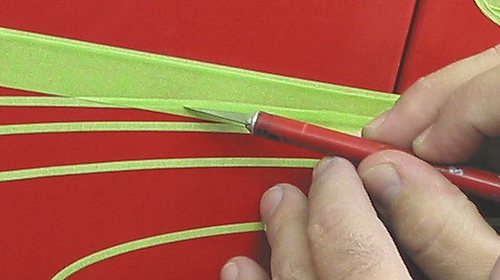 Because
the 3/4" tape overlaps the smallest end of some licks,
Because
the 3/4" tape overlaps the smallest end of some licks,
Ron has to carefully remove the overlap. |
| |
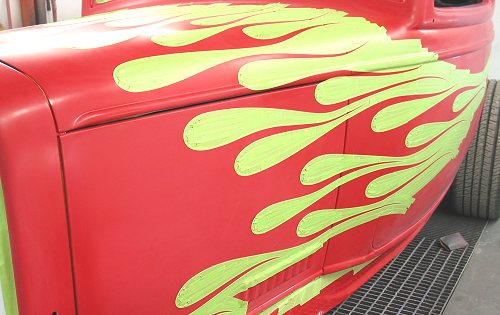 At
this point, all the negative areas are covered.
At
this point, all the negative areas are covered. |
| |
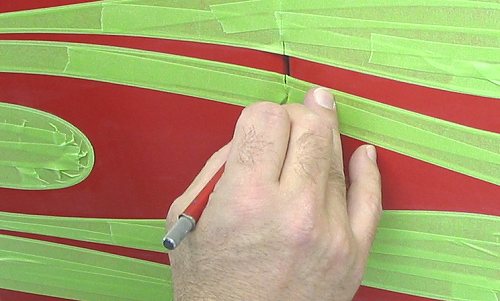
Ron
now moves to all of the door and hood openings.
He slices through then pushes the cut ends into the gaps.
|
| |
Once
this is complete, Ron goes over everything with a 3M plastic Sqeegee
to seal the tape so that everything is well sealed. Not only does
this ensure that nothing gets through the fill areas but it also ensures
crisp edges. Final preparations before paint involved masking off
the balance of the car. |
| |
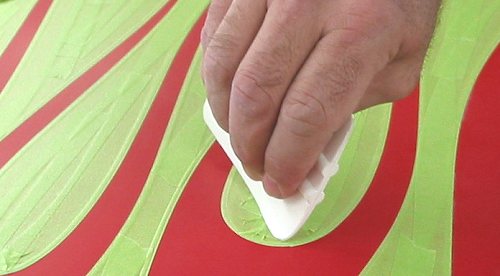 Ron
advises that you have to go over everything firmly
Ron
advises that you have to go over everything firmly
with the Squeegee to ensure that everything is sealed. |
| |
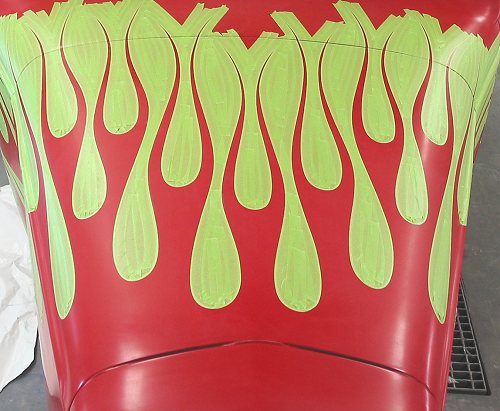 We're
diggn' this. Can't wait for colour.
We're
diggn' this. Can't wait for colour. |
| |
 The
results of another long session.
The
results of another long session. |
| |
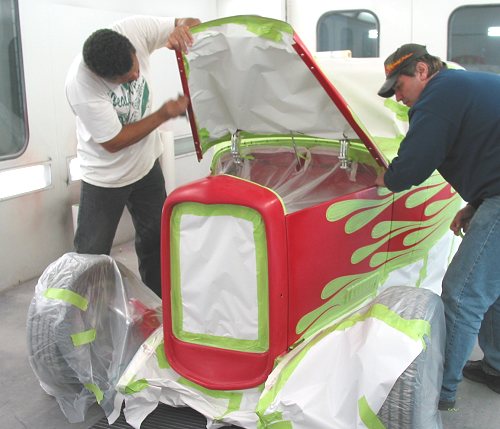 The
final step before paint is to complete the cover up process.
The
final step before paint is to complete the cover up process.
Lots of care is required here also. |
| |
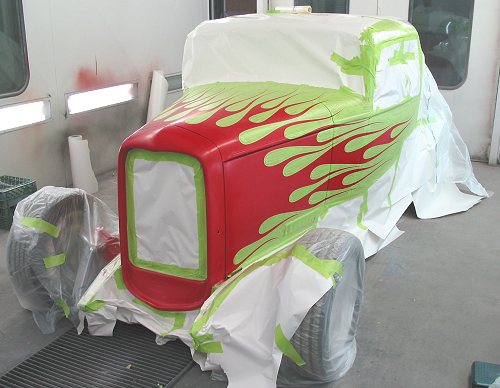 Ready
to "rock and roll"
Ready
to "rock and roll" |
| |
This
completes day 2. Day 3 will be exciting. |
| |
|

